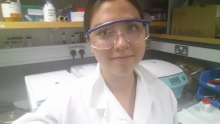
University:
Major:
Site Abroad:
Mentor(s):
Faculty Sponsor(s):
Faculty Sponsor's Department:
Project Title:
Project Description:
Liquid-Phase Exfoliation is a technique used to create two dimensional flakes from a bulk material. The technique relies on the use of a surfactant to separate and stabilize the two dimensional flakes. The ions of the surfactant are absorbed into the bulk material creating an overall surface charge associated with the material. This surface charge then attracts a layer of counter ions from the solution to form an electric double layer. This leads to columbic repulsion between the layers in the bulk material which helps separate them from each other. Three two dimensional materials were created throughout this research project. Two transition-metal dichalcogenides were produced: Tungsten (IV) Disulfide and Molybdenum Disulfide. As bulk crystals these materials have indirect band gaps, but as two dimensional flakes they have large direct gaps,which means these materials have the potential to be used as semiconductors. The last two dimensional material produced was antimony. Once exfoliated, the flakes of these materials were placed in a centrifuge at different speeds to undergo size selection. The materials were then characterized by UV/VIS spectroscopy and atomic force microscopy to determine the thickness of the flakes separated at each speed.
